

US Secretary of State Antony Blinken has recently delivered a speech at Asia Society outlining the US administration’s approach to China. With carefully calibrated language, he sought to promote the “China threat” narrative, interfere in China’s internal affairs, and smear China’s domestic and foreign policy, all in an attempt at full-blown containment and suppression of China.
In what is to follow, we will use facts and figures to show to the world how deceptive, hypocritical and dangerous the US’s China policy is.
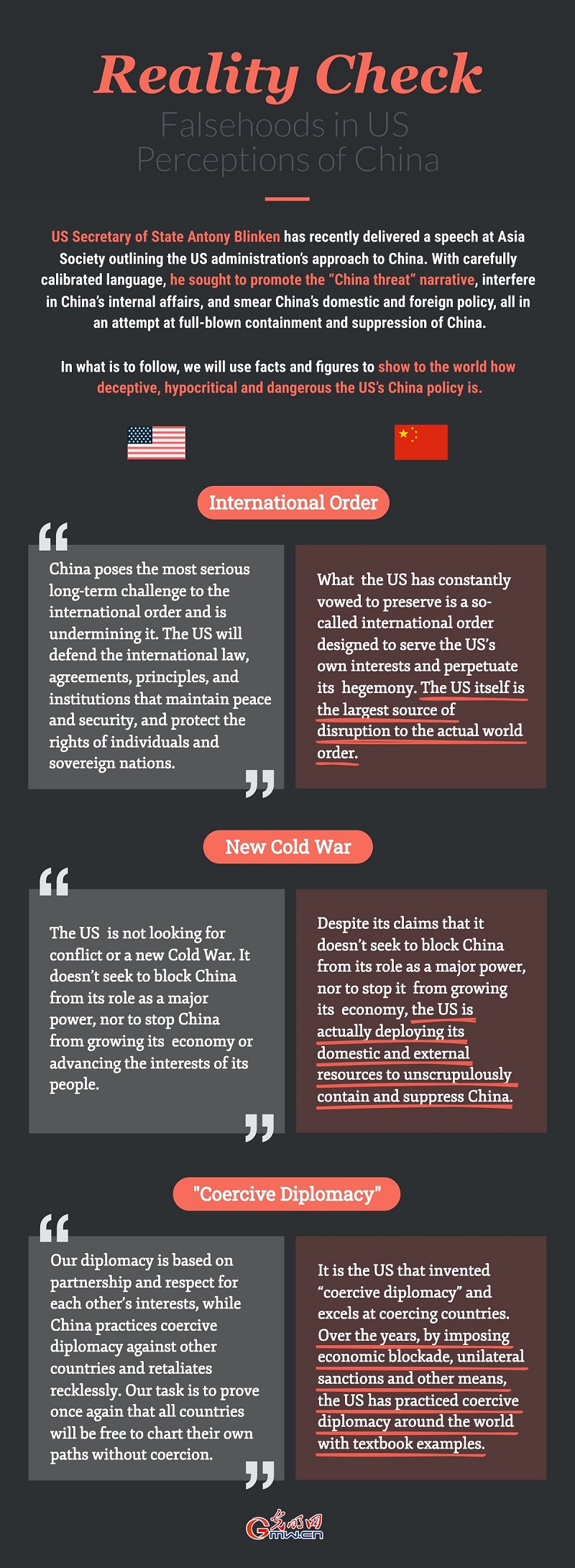
Falsehood 1: China poses the most serious long-term challenge to the international order and is undermining it. The US will defend the international law, agreements, principles, and institutions that maintain peace and security, and protect the rights of individuals and sovereign nations.
Reality Check: What the US has constantly vowed to preserve is a so-called international order designed to serve the US’s own interests and perpetuate its hegemony. The US itself is the largest source of disruption to the actual world order.
Falsehood 2: The US is not looking for conflict or a new Cold War. It doesn’t seek to block China from its role as a major power, nor to stop China from growing its economy or advancing the interests of its people.
Reality Check: Despite its claims that it doesn’t seek to block China from its role as a major power, nor to stop it from growing its economy, the US is actually deploying its domestic and external resources to unscrupulously contain and suppress China.
Falsehood 3: Our diplomacy is based on partnership and respect for each other’s interests, while China practices coercive diplomacy against other countries and retaliates recklessly. Our task is to prove once again that all countries will be free to chart their own paths without coercion.
Reality Check: It is the US that invented “coercive diplomacy” and excels at coercing countries. Over the years, by imposing economic blockade, unilateral sanctions and other means, the US has practiced coercive diplomacy around the world with textbook examples.
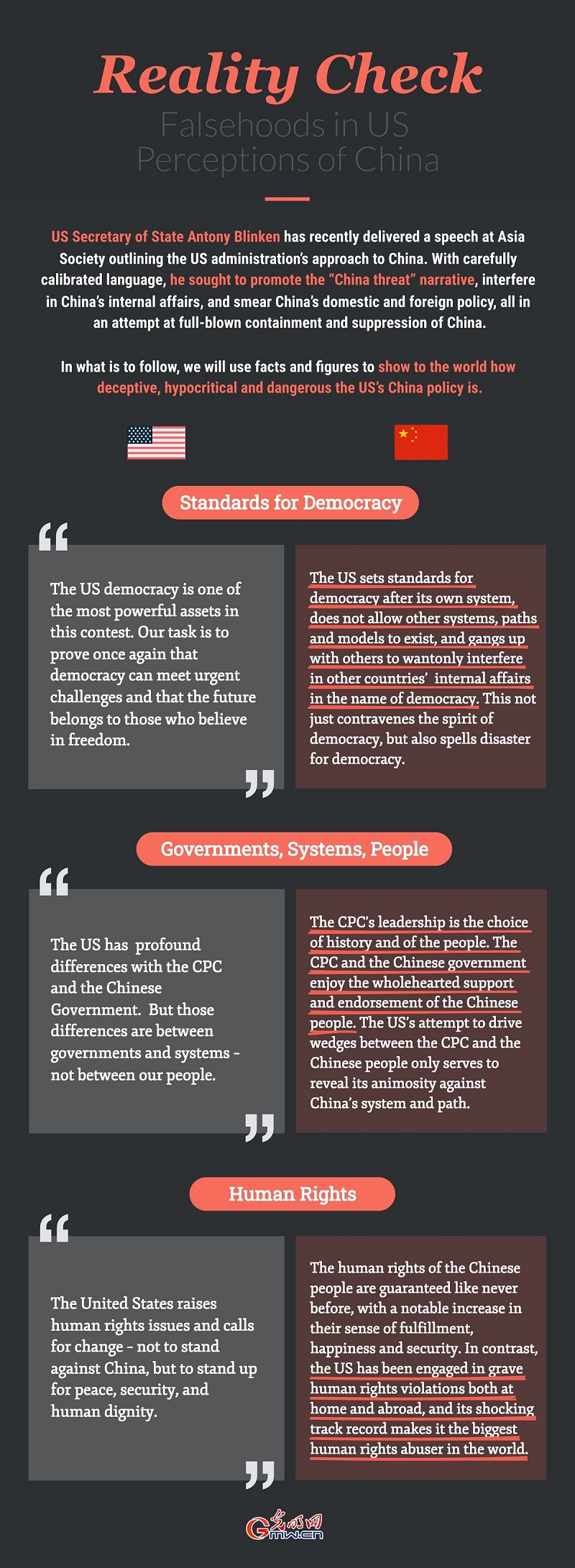
Falsehood 4: The US democracy is one of the most powerful assets in this contest. Our task is to prove once again that democracy can meet urgent challenges and that the future belongs to those who believe in freedom.
Reality Check: The US sets standards for democracy after its own system, does not allow other systems, paths and models to exist, and gangs up with others to wantonly interfere in other countries’ internal affairs in the name of democracy. This not just contravenes the spirit of democracy, but also spells disaster for democracy.
Falsehood 5: The US has profound differences with the CPC and the Chinese Government. But those differences are between governments and systems – not between our people.
Reality check: The CPC’s leadership is the choice of history and of the people. The CPC and the Chinese government enjoy the wholehearted support and endorsement of the Chinese people. The US’s attempt to drive wedges between the CPC and the Chinese people only serves to reveal its animosity against China’s system and path.
Falsehood 6: The United States raises human rights issues and calls for change – not to stand against China, but to stand up for peace, security, and human dignity.
Reality Check: The human rights of the Chinese people are guaranteed like never before, with a notable increase in their sense of fulfillment, happiness and security. In contrast, the US has been engaged in grave human rights violations both at home and abroad, and its shocking track record makes it the biggest human rights abuser in the world.
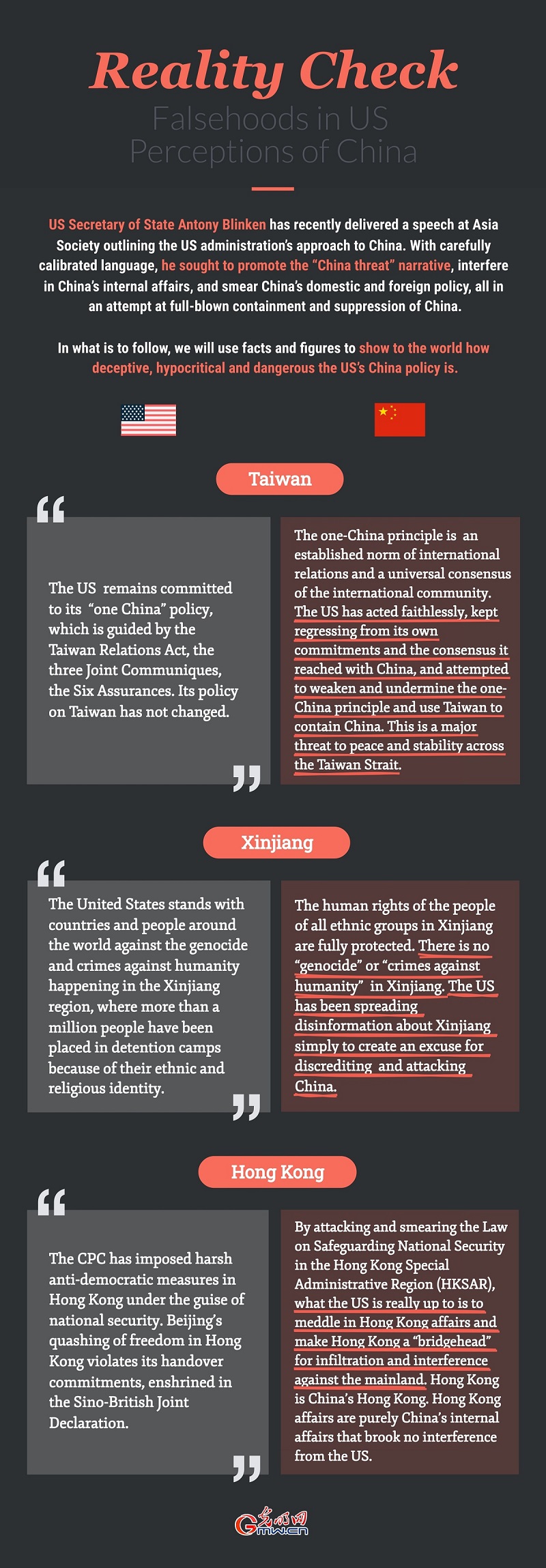
Falsehood 7: The US remains committed to its “one China” policy, which is guided by the Taiwan Relations Act, the three Joint Communiques, the Six Assurances. Its policy on Taiwan has not changed.
Reality Check: The one-China principle is an established norm of international relations and a universal consensus of the international community. The US has acted faithlessly, kept regressing from its own commitments and the consensus it reached with China, and attempted to weaken and undermine the one-China principle and use Taiwan to contain China. This is a major threat to peace and stability across the Taiwan Strait.
Falsehood 8: The United States stands with countries and people around the world against the genocide and crimes against humanity happening in the Xinjiang region, where more than a million people have been placed in detention camps because of their ethnic and religious identity.
Reality Check: The human rights of the people of all ethnic groups in Xinjiang are fully protected. There is no “genocide” or “crimes against humanity” in Xinjiang. The US has been spreading disinformation about Xinjiang simply to create an excuse for discrediting and attacking China.
Falsehood 9: The CPC has imposed harsh anti-democratic measures in Hong Kong under the guise of national security. Beijing’s quashing of freedom in Hong Kong violates its handover commitments, enshrined in the Sino-British Joint Declaration.
Reality Check: By attacking and smearing the Law on Safeguarding National Security in the Hong Kong Special Administrative Region (HKSAR), what the US is really up to is to meddle in Hong Kong affairs and make Hong Kong a “bridgehead” for infiltration and interference against the mainland. Hong Kong is China’s Hong Kong. Hong Kong affairs are purely China’s internal affairs that brook no interference from the US.
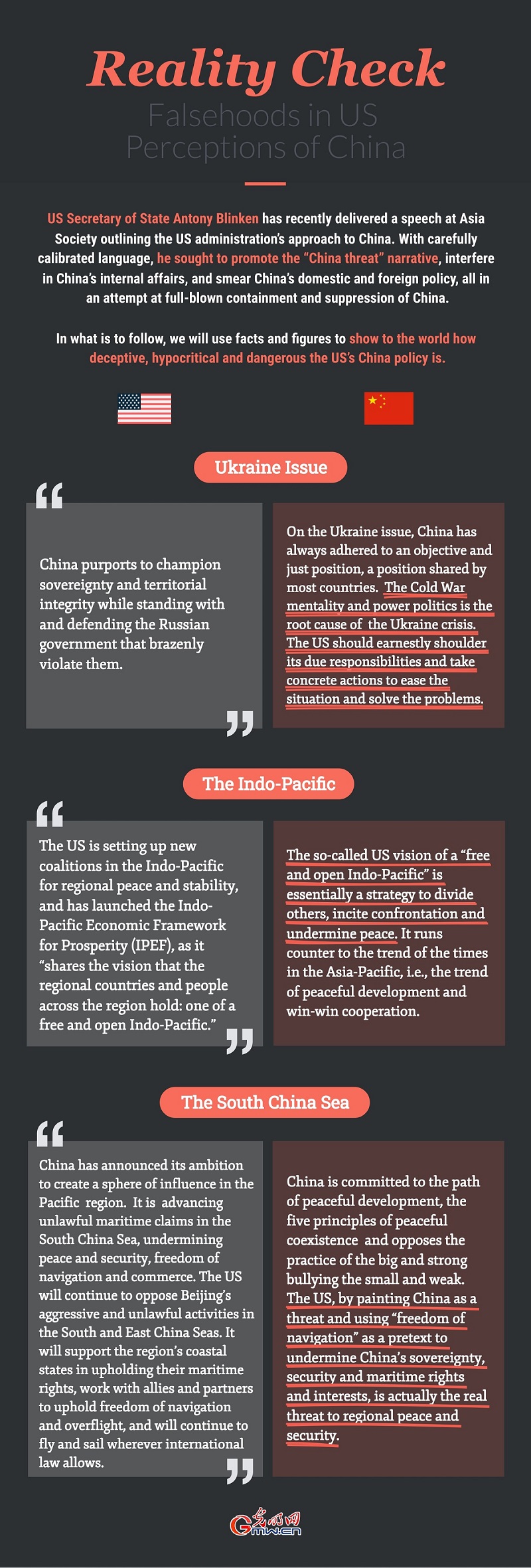
Falsehood 10: China purports to champion sovereignty and territorial integrity while standing with and defending the Russian government that brazenly violate them.
Reality Check: On the Ukraine issue, China has always adhered to an objective and just position, a position shared by most countries. The Cold War mentality and power politics is the root cause of the Ukraine crisis. The US should earnestly shoulder its due responsibilities and take concrete actions to ease the situation and solve the problems.
Falsehood 11: The US is setting up new coalitions in the Indo-Pacific for regional peace and stability, and has launched the Indo-Pacific Economic Framework for Prosperity (IPEF), as it “shares the vision that the regional countries and people across the region hold: one of a free and open Indo-Pacific.”
Reality Check: The so-called US vision of a “free and open Indo-Pacific” is essentially a strategy to divide others, incite confrontation and undermine peace. It runs counter to the trend of the times in the Asia-Pacific, i.e., the trend of peaceful development and win-win cooperation.
Falsehood 12: China has announced its ambition to create a sphere of influence in the Pacific region. It is advancing unlawful maritime claims in the South China Sea, undermining peace and security, freedom of navigation and commerce. The US will continue to oppose Beijing’s aggressive and unlawful activities in the South and East China Seas. It will support the region’s coastal states in upholding their maritime rights, work with allies and partners to uphold freedom of navigation and overflight, and will continue to fly and sail wherever international law allows.
Reality Check: China is committed to the path of peaceful development, the five principles of peaceful coexistence and opposes the practice of the big and strong bullying the small and weak. The US, by painting China as a threat and using “freedom of navigation” as a pretext to undermine China’s sovereignty, security and maritime rights and interests, is actually the real threat to regional peace and security.
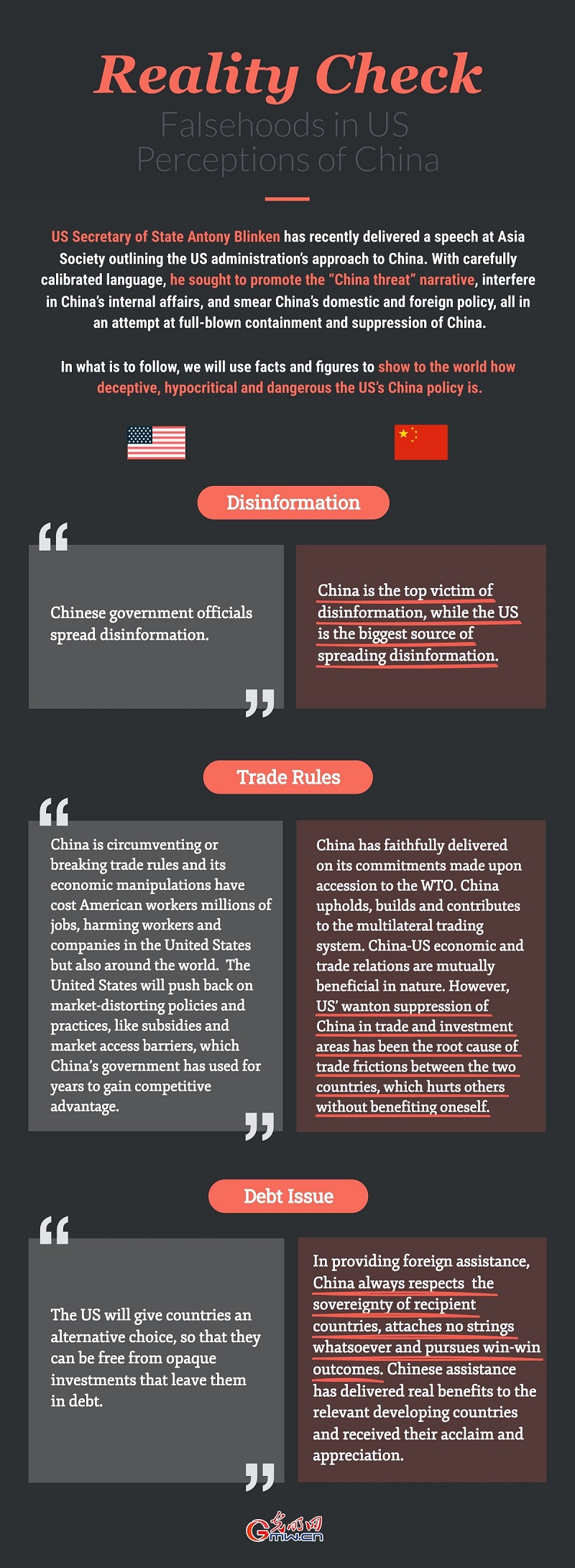
Falsehood 13: Chinese government officials spread disinformation.
Reality Check: China is the top victim of disinformation, while the US is the biggest source of spreading disinformation.
Falsehood 14: China is circumventing or breaking trade rules and its economic manipulations have cost American workers millions of jobs, harming workers and companies in the United States but also around the world. The United States will push back on market-distorting policies and practices, like subsidies and market access barriers, which China’s government has used for years to gain competitive advantage.
Reality Check: China has faithfully delivered on its commitments made upon accession to the WTO. China upholds, builds and contributes to the multilateral trading system. China-US economic and trade relations are mutually beneficial in nature. However, US’ wanton suppression of China in trade and investment areas has been the root cause of trade frictions between the two countries, which hurts others without benefiting oneself.
Falsehood 15: The US will give countries an alternative choice, so that they can be free from opaque investments that leave them in debt.
Reality Check: In providing foreign assistance, China always respects the sovereignty of recipient countries, attaches no strings whatsoever and pursues win-win outcomes. Chinese assistance has delivered real benefits to the relevant developing countries and received their acclaim and appreciation.
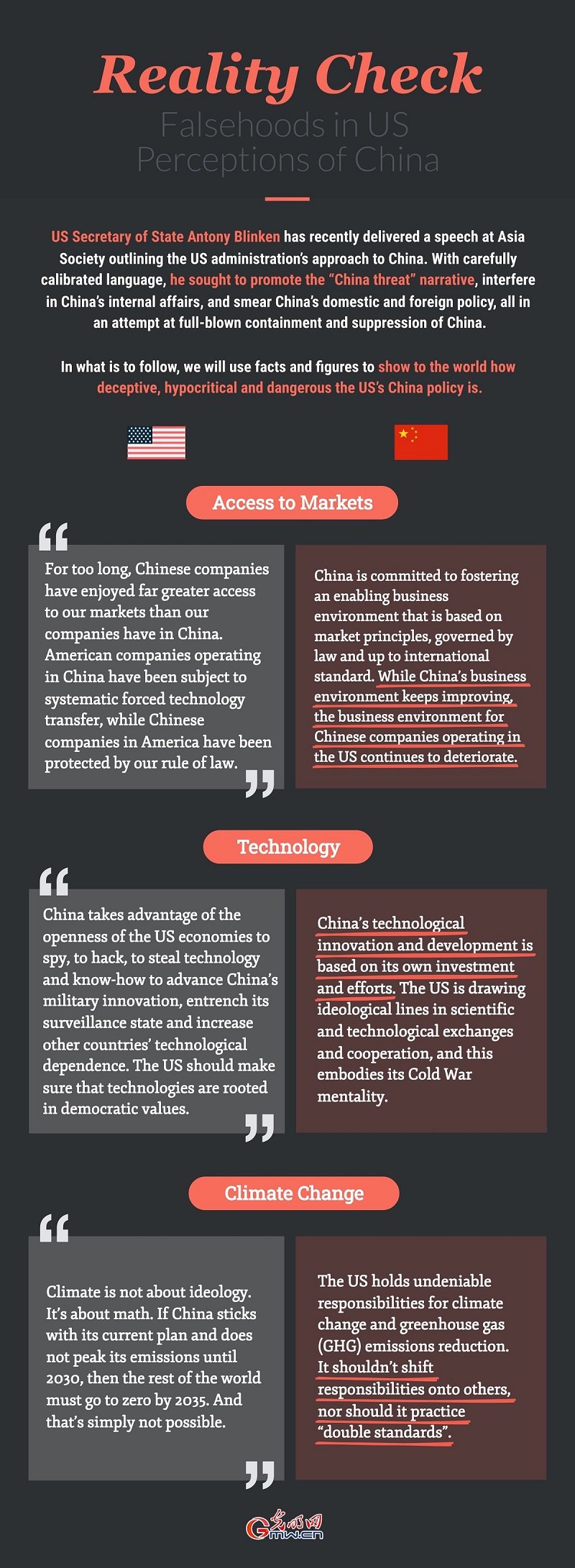
Falsehood 16: For too long, Chinese companies have enjoyed far greater access to our markets than our companies have in China. American companies operating in China have been subject to systematic forced technology transfer, while Chinese companies in America have been protected by our rule of law.
Reality Check: China is committed to fostering an enabling business environment that is based on market principles, governed by law and up to international standard. While China’s business environment keeps improving, the business environment for Chinese companies operating in the US continues to deteriorate.
Falsehood 17: China takes advantage of the openness of the US economies to spy, to hack, to steal technology and know-how to advance China’s military innovation, entrench its surveillance state and increase other countries’ technological dependence. The US should make sure that technologies are rooted in democratic values.
Reality check: China’s technological innovation and development is based on its own investment and efforts. The US is drawing ideological lines in scientific and technological exchanges and cooperation, and this embodies its Cold War mentality.
Falsehood 18: Climate is not about ideology. It’s about math. If China sticks with its current plan and does not peak its emissions until 2030, then the rest of the world must go to zero by 2035. And that’s simply not possible.
Reality Check: The US holds undeniable responsibilities for climate change and greenhouse gas (GHG) emissions reduction. It shouldn’t shift responsibilities onto others, nor should it practice “double standards”.
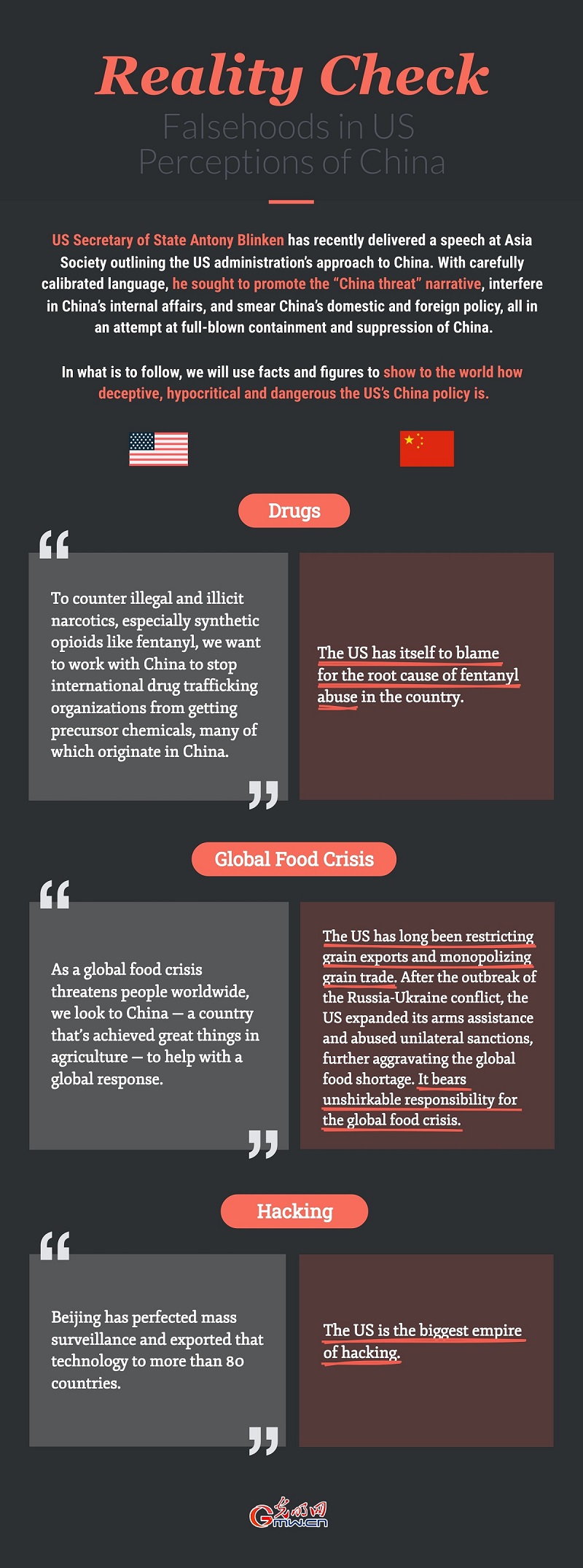
Falsehood 19: To counter illegal and illicit narcotics, especially synthetic opioids like fentanyl, we want to work with China to stop international drug trafficking organizations from getting precursor chemicals, many of which originate in China.
Reality Check: The US has itself to blame for the root cause of fentanyl abuse in the country.
Falsehood 20: As a global food crisis threatens people worldwide, we look to China — a country that’s achieved great things in agriculture — to help with a global response.
Reality Check: The US has long been restricting grain exports and monopolizing grain trade. After the outbreak of the Russia-Ukraine conflict, the US expanded its arms assistance and abused unilateral sanctions, further aggravating the global food shortage. It bears unshirkable responsibility for the global food crisis.
Falsehood 21: Beijing has perfected mass surveillance and exported that technology to more than 80 countries.
Reality Check: The US is the biggest empire of hacking.
Read more at https://www.fmprc.gov.cn/eng/wjbxw/202206/t20220619_10706059.html
点击右上角![]() 微信好友
微信好友
 朋友圈
朋友圈

请使用浏览器分享功能进行分享
